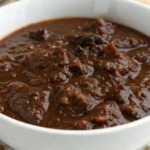Inspired by a lifelong love for simple yet flavorful cooking, I share recipes that blend ease with elegance. Baked Pink Salmon with Lemon and Herbs perfectly captures that balance. With its delicate texture, citrusy brightness, and nourishing appeal, this dish embodies my mission at Eminent Recipes—to create meals that are both approachable and memorable. Whether you’re a beginner or a seasoned cook, this is a recipe worth adding to your go-to list.
Table of Contents

Pondu
- Total Time: 1 hour 50 minutes
- Yield: 4–6 servings 1x
- Diet: Gluten Free
Description
Pondu, a rich Congolese stew made from cassava leaves, blended vegetables, palm oil, and smoked fish, is bold, earthy, and deeply comforting. Slowly simmered to develop flavor, it’s a staple across Central Africa and best served with rice, fufu, or plantains for a hearty, traditional meal.
Ingredients
- 500 g of frozen cassava leaves
- A bunch greens onions
- 1 bulb of garlic
- 2 yellow onions
- 1 leek
- 2 green peppers
- 1 cup of palm oil
- 2 Tbsp of salt
- 1 smoked fish
- Green habanero pepper (optional)
Instructions
- Rehydrate the smoked fish in boiled water for 20 min. Clean the fish by removing everything except the flesh. Set aside.
- Blend the onions, garlic, green onions, leek, and green peppers in a food processor.
- Put the cassava leaves with your onion mixture in a large pot with enough water to cover the cassava leaves on high heat.
- Add the salt and palm oil. Let it boil for 30 min.
- After 30 min, add the smoked fish, habanero pepper and let it boil for 1 hour.
- During that hour, keep adding 2 cups of water each time the water runs out.
Notes
- Pondu is traditionally served with fufu, rice, or boiled plantains.
- The palm oil gives it its rich flavor and color—don’t skip it!
- For added protein, you can include beef or smoked turkey along with the fish.
- Prep Time: 20 minutes
- Cook Time: 1 hour 30 minutes
- Category: Main Dish
- Method: Boiling, Simmering
- Cuisine: Congolese / Central African
Cassava Leaves (Pondu) Recipe
History of Cassava Leaves in African Cooking
Cassava leaves, also known as pondu in Congo or saka-saka in other regions, have deep historical roots in African cuisine. Introduced to Africa from South America in the 16th century through Portuguese traders, cassava plants quickly adapted to tropical climates. While the starchy roots gained popularity as a staple, the leaves evolved into a crucial part of many traditional dishes, particularly in Central and West Africa.
Throughout generations, cassava leaves have been valued not only for their flavor but also for their nutritional benefits—rich in iron, calcium, and plant protein. In regions where access to varied vegetables is limited, cassava leaves became an essential source of greens and sustenance. African cooking methods developed to detoxify and enhance the leaves’ natural bitterness through boiling, pounding, and long stewing times with aromatic spices and palm oil.
Cultural Importance in the Congo and Beyond
In the Democratic Republic of Congo, pondu isn’t just food—it’s tradition, identity, and celebration. It’s served at family gatherings, weddings, and holidays, always symbolizing hospitality and heritage. Across Africa and within the diaspora, pondu continues to unite people with shared roots. It reflects resilience, resourcefulness, and the enduring value of communal meals passed down through time.
Don’t miss our flavorful twist on traditional greens with this high-protein cottage cheese recipe for more nutrient-rich ideas.
What Are Cassava Leaves’ Health Benefits?
Rich in Fiber, Iron, and Antioxidants
Cassava leaves are a powerhouse of nutrition, offering an impressive array of health benefits. They are especially rich in dietary fiber, which supports digestion and gut health. The high iron content makes pondu an excellent option for those needing to boost their hemoglobin levels—particularly important in regions where anemia is common. Additionally, cassava leaves contain calcium, potassium, and vitamin C, all contributing to stronger bones, better immunity, and improved cellular health.
One of the most valuable health aspects of cassava leaves is their antioxidant load. These antioxidants help combat inflammation and protect the body from oxidative stress, which is linked to chronic diseases such as heart conditions and diabetes. When cooked correctly with ingredients like garlic, onions, and palm oil, the nutritional profile is enhanced without compromising flavor.
Comparing Pondu to Other Leafy Stews Globally
Globally, many cultures have their own nutrient-rich leafy stews—like spinach saag from India, collard greens in Southern U.S. cuisine, and moringa leaf stews across West Africa. Compared to these, pondu holds its ground as both flavorful and functional. It’s one of the few leafy dishes that combines intense taste with dense micronutrients, making it a standout in the global family of green stews.
Check out this baked pink salmon recipe to pair with pondu for a balanced, heart-healthy meal.
Serving Suggestions – What Goes with Pondu?
Pondu pairs beautifully with several traditional African sides. Rice and pondu make a fiber- and iron-rich combo that supports digestion and sustained energy. For a heartier plate, fufu—made from cassava, plantains, or yams—is a common choice, offering slow-burning carbs that complement the stew’s texture. Fried or boiled plantains add natural sweetness and balance to pondu’s earthy flavor. As part of a balanced meal plan, pondu delivers essential micronutrients and plant protein when combined with whole grains or lean meats, making it both a culturally authentic and health-conscious dish.
How Do You Make Cassava Leaves Recipe?
To make cassava leaves (pondu), boil finely chopped cassava leaves until tender, then simmer with palm oil, onions, garlic, chili, and your choice of smoked fish, meat, or peanut butter. Cook slowly for rich flavor. This traditional method enhances taste while preserving the leaves’ powerful nutrients.
Storage, Reheating, and Meal Prep
Pondu, like many stews, stores well and often tastes even better the next day as flavors deepen. In the refrigerator, properly stored pondu lasts up to 4–5 days. To keep it fresh, allow it to cool completely before transferring it to an airtight container. Always store in the coldest part of the fridge and avoid repeated reheating from the same container.
For long-term storage, freezing pondu is a great option. Divide it into portioned freezer-safe bags or containers and label with the date. It can last up to 3 months frozen without major loss in taste or texture. When freezing, avoid including starchy sides like fufu or rice—freeze only the stew for best results.
To reheat pondu without sacrificing nutrients or flavor, let it thaw overnight in the fridge if frozen. Warm it over low to medium heat on the stove, stirring occasionally. Add a splash of water or broth if it thickens too much. Avoid microwaving at high temperatures, as it can dry out or overcook the ingredients.
Don’t miss our stuffed peppers with rice and hamburger for another hearty meal that reheats beautifully!
Cassava Leaves (Pondu) Recipe
Ingredients
- 500 g of frozen cassava leaves
- A bunch greens onions
- 1 bulb of garlic
- 2 yellow onions
- 1 leek
- 2 green peppers
- 1 cup of palm oil
- 2 Tbsp of salt
- 1 smoked fish
- Green habanero pepper (optional)
Instructions
- Rehydrate the smoked fish in boiled water for 20 min. Clean the fish by removing everything except the flesh. Set aside.
- Blend the onions, garlic, green onions, leek, and green peppers in a food processor.
- Put the cassava leaves with your onion mixture in a large pot with enough water to cover the cassava leaves on high heat.
- Add the salt and palm oil. Let it boil for 30 min.
- After 30 min, add the smoked fish, habanero pepper and let it boil for 1 hour.
- During that hour, keep adding 2 cups of water each time the water runs out.
Discover great ideas like this jerk chicken pasta Alfredo for a spicy fusion meal to pair with your next African-inspired feast.
Want more sweet and savory recipes like this? Follow us on Facebook for daily dinner ideas, cooking tips, and behind-the-scenes moments from Eminent Recipes.
See how others are plating this dish on Instagram! Tag your version with #EminentEats and get featured.
Love collecting recipes? Don’t miss our latest pins on Pinterest—perfect for saving your favorite meals in one spot.
FAQs
What is Pondu made of?
Pondu is made from finely chopped cassava leaves simmered with palm oil, onions, garlic, chili, and optional protein like fish or meat.
Is rice and Pondu healthy?
Yes, pairing pondu with rice creates a fiber-rich, iron-packed, and balanced meal, especially when using brown rice.
What is the English name for Pondu vegetables?
Pondu vegetables are called cassava leaves or manioc leaves in English.
Is cassava leaf stew healthy?
Absolutely. Cassava leaves are rich in iron, fiber, and antioxidants, making pondu a nutritious addition to any diet.
Conclusion
Pondu is more than just a traditional African dish—it’s a flavorful, nutrient-dense stew that bridges culture, health, and comfort. Packed with iron, antioxidants, and bold taste, it deserves a spot in every kitchen. Whether paired with rice, fufu, or enjoyed solo, cassava leaf stew is both satisfying and symbolic. As more people explore global flavors, pondu stands out as a delicious, easy-to-make recipe rooted in rich history and nourishing tradition.

